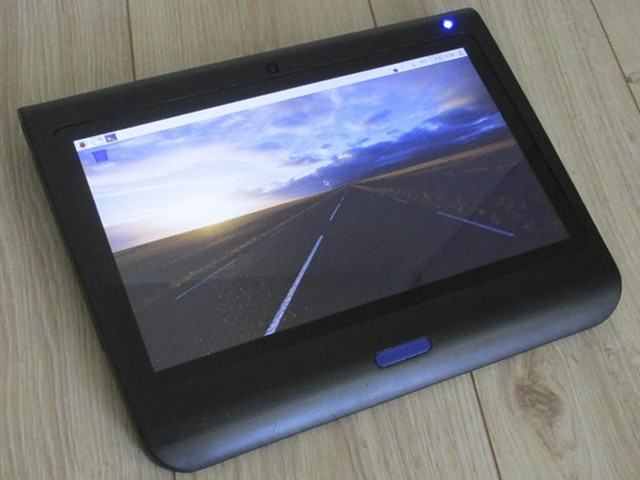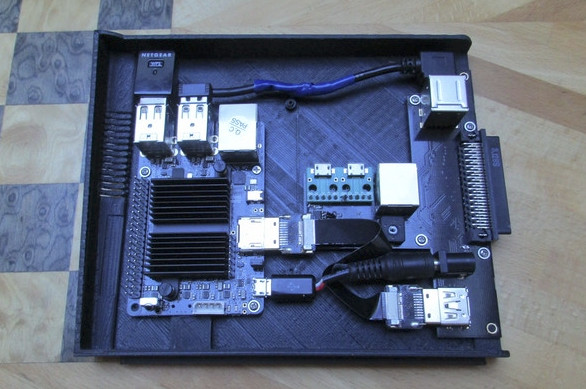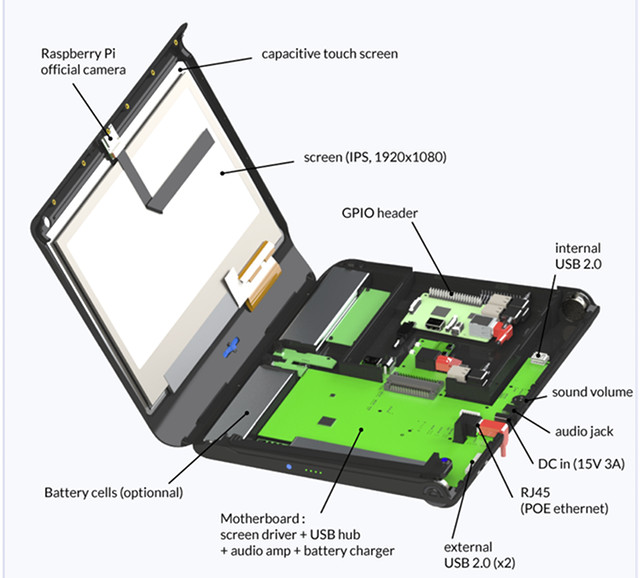If your project requires a touch panel, there are plenty of solutions for Raspberry Pi and ODROID boards, with Hardkernel even selling ODROID-VU8C fully integrated touch panel display. However, most display kits require you to make your own case, and feature smaller displays with lower resolution. One developer has however come up with Diskio Pi, a higher-end touch panel kit with a 13.3″ Full HD display that works with the most popular Raspberry Pi and ODROID boards.

Diskio Pi specifications:
- Display – 13.3″ AUO TFT IPS display with 1920×1080 resolution connected via a 30-pin eDP connector ; 330 cd/m2 brightness; 85° viewing angles in all directions.
- Touch panel – 10-point capacitive touch; G/G structure; USB 2.0 interface; ≥6H surface hardness.
- Main board:
- HDMI to eDP driver
- Stereo sound amplifier
- USB 2.0 hub with 3x ports: 2x external + 1x internal
- Battery balance circuit (3S/3S2P)
- Expansion – Various headers for prototyping (RJ45, USB…)
- Misc – Left & right mouse buttons (home button, USB); circuit protection via fuses, diodes…
- Power Supply – RJ45 POE+ (Power over Ethernet)
- Rack board:
- Connections with the board via cables: 4 x USB, 2 x Ethernet, 1 x Power, 1 x HDMI
- Fan circuit with potentiometer (fan will be optional)
- Speakers – 2x round 3W speakers
- Power Supply – 5V 3A from main board
- Power Supply – 15 or 18V AC/DC adapter with EU, UK or US plug
- Battery – Optional 6 cells LiPo 3.7V=11.1V, 8000mAh
- Dimensions – 348 x 265 x 25 mm (Final dimensions may change slightly)
- Weight – 1.8 kg (prototype)

Diskio Pi is currently compatible with Raspberry Pi 2, Raspberry Pi 3, Raspberry Pi Zero (W), ODROID C1+, and ODROID C2, but later, a modified kit will offer support for ODROID XU4 and Intel Atom based UP board. You can run any operating system you’d like since HDMI is used for video output (and converted to eDP), and USB used for the touch panel. You’ll be able to use accessories like the official Raspberry Pi camera, and there’s even space to add extra boards or modules like an Arduino mini or sensors using the IO headers or the internal USB port. The kit could be use as a large (and thick) tablet, an home automation dashboard, a portable Linux computer, etc…
The project has just been launched on Kickstarter with the aim of raising at least 400,000 Euros, which may prove to be a challenge, but we’ll see. The “very early adopter pack” rewards requires a 350 Euros pledge for Diskio Pi with the power adapter, but no battery, nor a Raspberry Pi or ODROID board. The 45 Euros battery pack is optional is reserved “for users who don’t need the POE+ power”. Shipping adds 9 Euros to France, 16 Euros to most of Europe, and 36 Euros to the rest of the world, with delivery scheduled for February 2018. The person behind the project has 10-year experience as… an optician, but he’s been working on the prototype for 18 months, and Advansee will take care of the final embedded electronics design, while CD-Plast will handle the mechanical design, with both companies based in the west of France.
https://www.kickstarter.com/projects/1484696121/diskio-pi-the-ultime-open-source-tablet

Jean-Luc started CNX Software in 2010 as a part-time endeavor, before quitting his job as a software engineering manager, and starting to write daily news, and reviews full time later in 2011.
Support CNX Software! Donate via cryptocurrencies, become a Patron on Patreon, or purchase goods on Amazon or Aliexpress





